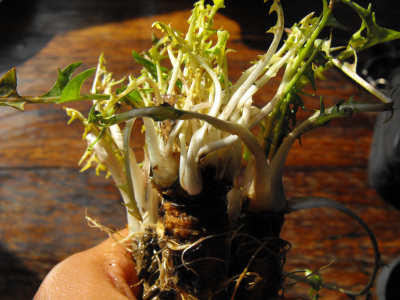
Dandelions: Dynamic accumulator and edible
 Last
winter, my forest gardening map put dandelions amid the
other dynamic
accumulators around
the bases of my fruit trees. But I just couldn't make myself put
the dandelions in the ground. Here I was hacking at the long
taproots in my vegetable garden beds, and I wanted to plant some dandelions elsewhere in
the garden? Was I nuts?
Last
winter, my forest gardening map put dandelions amid the
other dynamic
accumulators around
the bases of my fruit trees. But I just couldn't make myself put
the dandelions in the ground. Here I was hacking at the long
taproots in my vegetable garden beds, and I wanted to plant some dandelions elsewhere in
the garden? Was I nuts?
But a bit of research
suggests that dandelions have a lot going for them. They are
dynamic accumulators of sodium, silica, magnesium, calcium, potassium,
phosphorus, iron, and copper, which means they could bring trace
minerals to the surface where the tree roots can access them.
Dandelions are also an early, prolific bloomer that feeds honeybees
both pollen and nectar in the spring before many other flowers are
out. Plus, dandelions are perennials that self sow readily, so
they can fill gaps in the forest garden that might otherwise come up in
less helpful weeds.
I didn't get pushed over
the edge, though, until our larder started getting pretty bare and I
decided to find some spring greens to saute for lunch. I'd been
eying the dandelion greens since early March, remembering that they
were an edible but suspecting that they were also quite bitter.
When a walk around the yard turned up only a handful of creasies and
Egyptian onion tops, I decided to round out my pot with young dandelion
leaves, and the result was scrumptious! Perennial greens that are
ready to eat in early March with no care on my part? I think
dandelions have finally won a place in the forest garden. Now I
just have to decide if I'm going for the wild version or am actually
going to pay money for cultivated dandelion seeds.
Want more in-depth information? Browse through our books.
Or explore more posts by date or by subject.
About us: Anna Hess and Mark Hamilton spent over a decade living self-sufficiently in the mountains of Virginia before moving north to start over from scratch in the foothills of Ohio. They've experimented with permaculture, no-till gardening, trailersteading, home-based microbusinesses and much more, writing about their adventures in both blogs and books.
Want to be notified when new comments are posted on this page? Click on the RSS button after you add a comment to subscribe to the comment feed, or simply check the box beside "email replies to me" while writing your comment.
- Remove comment

- Remove comment
- Remove comment
- Remove comment
- Remove comment
- Remove comment
- Remove comment

- Remove comment
